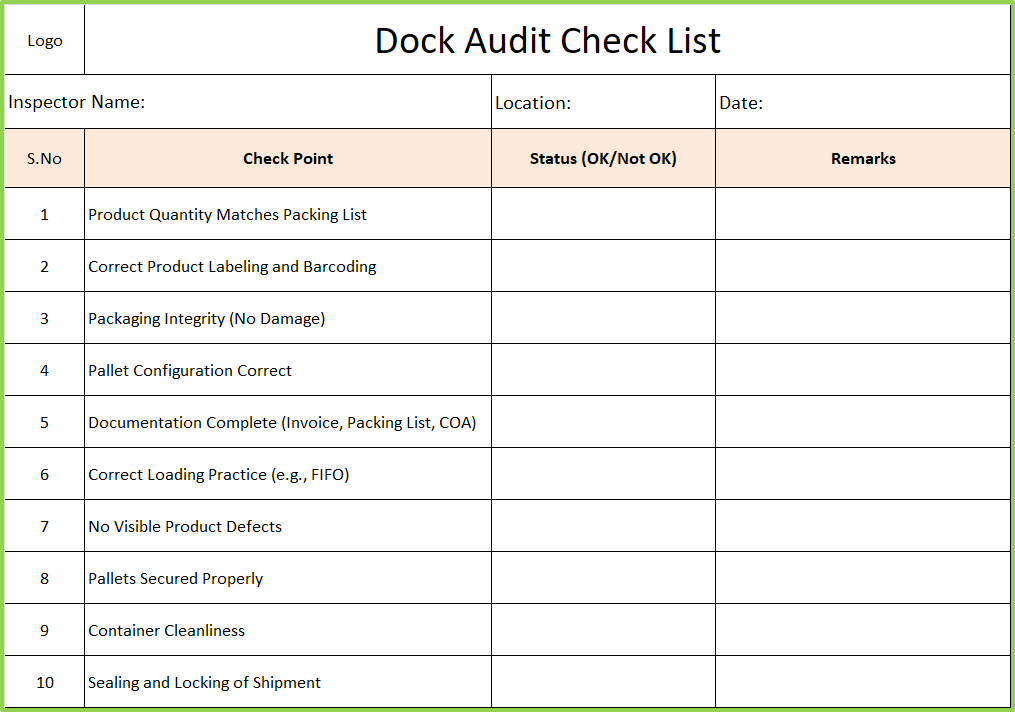In the fast-paced world of manufacturing, ensuring product quality doesn’t stop once the item leaves the production line. One of the final—but most crucial—steps in the quality control process is the dock audit.
What is a Dock Audit?
A dock audit is a final inspection conducted at the shipping or receiving dock of a manufacturing facility. Its main purpose is to verify that products being shipped meet quality standards, packaging requirements, labeling, and documentation accuracy before they leave the premises or are received into inventory.
This checkpoint helps prevent defective or non-conforming products from reaching the customer—a step that saves time, cost, and reputation.
What Does a Dock Audit Include?
A typical dock audit includes checking:
- Product quantity against the shipment documents
- Labeling and barcodes for accuracy
- Packaging quality and damage prevention
- Documentation (e.g., invoice, packing list, etc.)
- Correct loading practices (e.g., FIFO, no damage during transit)
- Visual quality checks for defects or anomalies
- Pallet configuration and weight limits
Dock Audit Check Sheet in Excel:
The dock audit checklist contains all the checkpoints as discussed. The quality inspector verifies all the checkpoints before dispatch. Check each point’s status and if found not OK, then write an observation in the remarks.

Note: The Audit checklist can be revised as per the company’s requirements.
Benefits of Performing Dock Audits
- Prevents customer complaints and rejections
- Ensures compliance with quality standards
- Improves traceability and documentation accuracy
- Reduces logistics-related issues
- Boosts customer satisfaction and trust
Frequency and Responsibility

Dock audits can be conducted daily, weekly, or on a per-shipment basis, depending on the criticality of the product. They are typically carried out by quality inspectors or trained shipping personnel.
What to do if the dock audit fails
- Hold the shipment immediately to prevent dispatch.
- Segregate the non-conforming products.
- Record the issue in the audit log or NC register with full details.
- Inform QA, Logistics, and Production teams promptly.
- Perform root cause analysis (e.g., 5 Whys, Fishbone Diagram).
- Take corrective action, such as rework, relabeling, or replacement.
- Conduct a re-audit to verify resolution.
- Approve and release the shipment only after it has been closed.
- Implement preventive actions to avoid recurrence.
- Notify the customer if the issue has already impacted them.
Conclusion
A dock audit is more than a routine checklist—it’s a critical quality gate that ensures only compliant, properly packaged, and defect-free products reach your customers. Regular dock audits help build a culture of quality and accountability across departments.
By implementing dock audits consistently, manufacturers can:
- – Reduce customer complaints and returns
- – Improve compliance with regulatory and customer requirements
- – Minimize logistics-related risks
- – Strengthen traceability and documentation accuracy
- – Increase confidence in outgoing and incoming shipments
You may also like to read about:
Process audit in a manufacturing industry
Internal Audit Checklist for all departments in a manufacturing industry


Hello there! I just wish to offer you a huge thumbs up for the excellent information you have got right here on this post. I am returning to your blog for more soon.
I savour, result in I discovered exactly what I used to be having a look for. You have ended my 4 day lengthy hunt! God Bless you man. Have a great day. Bye
Very nice write-up. I absolutely appreciate this website. Keep writing!
My brother recommended I might like this blog. He was totally right. This post truly made my day. You can not imagine just how much time I had spent for this info! Thanks!